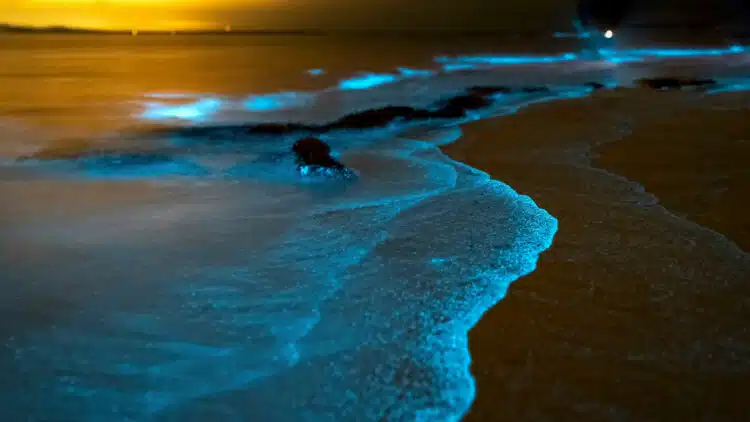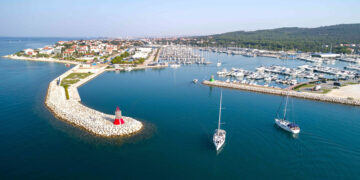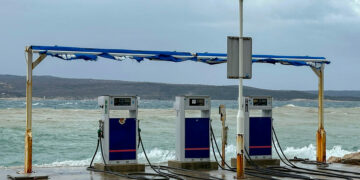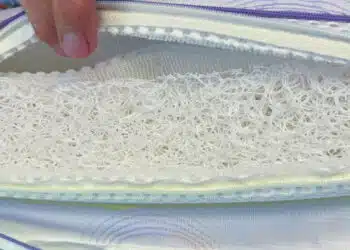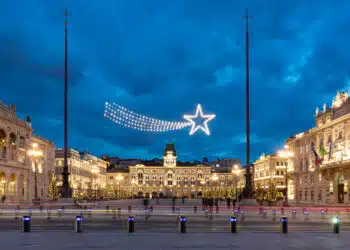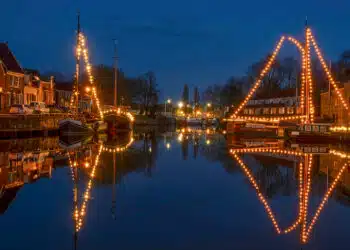Seawater that seems to luminesce blue to green, that sounds almost like a sequence from the science fiction thriller “The Swarm” by Frank Schätzing. Although scientists now seem to agree on what triggers the light in the sea, the exact framework conditions for the occurrence of this phenomenon (sea light) are still not completely clarified..
Who has experienced the sea light once, never forgets this feeling of happiness again. The first time I was allowed to experience it a few years ago in the Queen’s Gardens southeast of Cuba. It was as if the underwater lighting on the hulls of our chartered sailing cat had suddenly been turned on. Some time later, we were sailing SY KAIROS in Greek waters, our bodies lit up during a nighttime swim in the sea as we lay at anchor.
And once again we saw the sea glow: it happened just a few days ago on the coast of a small Maldivian island in Raa Atoll. The waves gently rolling in on the beach lit up and illuminated the otherwise black night with millions of tiny dots; with each step we took on the beach, the ground – and the soles of our feet – lit up bright green. For quite some time later, we could still make out our illuminated footprints in the sand, until the next luminous surge washed the tracks away.
Jules Verne suspected myriads of infusion animals behind the sea glow
But what was the mysterious glow all about? Jules Verne was sure he knew exactly the cause: in his novel 20,000 Leagues Under the Sea, he wrote that the white light in the sea was produced by “myriads of infusion animals.” These creatures are “luminous worms that are colorless, hair-thin and no longer than a fifth of a millimeter. They form a gelatinous layer often miles wide.”
Science was also in the dark about the phenomenon for a long time. Many sailors’ stories told of the milky, luminous sea. But for a long time there was no really conclusive explanation. Above all, the glow seemed to occur completely unexpectedly. Only by chance did a satellite record images of a huge milky patch off the coast of Somalia. The ocean glow lasted for three days; it was thought to have occurred in association with a “cold, swirling ocean current.”
So-called bioluminescence can be observed on the coast and in the open sea
It is now certain that the light phenomena in the sea known as marine luminescence are attributed to so-called bioluminescence, and that the phenomenon can be observed both on the coast and in the open sea. Microorganisms such as dinoflagellates, single-celled organisms that actually belong to the algae family, are thought to be responsible for this.
When the sea glows, the seawater seems to luminesce blue to green – as if you were in the midst of the swarm from Frank Schätzing’s science fiction, which was recently made into a film. In fact, it is not the seawater itself that glows, but the microorganisms in the seawater. These emit more or less long-lasting light signals after a touch stimulus.
The glow of the protozoa is triggered by touch stimuli, the stronger the brighter
That the glow is triggered by touch stimuli was well observed by us on the beach of the small Maldives island of Dhigali in Raa Atoll. On the one hand, the sea glow was caused by the weak surf, on the other hand, we were able to evoke it in the white sand of the beach by simply running and stroking our feet along the sand. The organisms that we had touched in the process became visible as small glowing dots.
Some experts suspect that the pressure on the cell wall of the unicellular organisms influences the ion channels within it. According to the researchers, it is conceivable that the pressure from outside could cause these channels to open, allowing calcium to move through various parts of the cell and trigger the light reaction. How bright the luminescent color is depends on how hard and how fast the cell wall is pressed in, they said.
The general conditions for the appearance of the microorganisms have not been completely clarified
But that was it with the established facts about the sea glow. The effect is to be found only occasionally, because the necessary microorganisms appear only rarely in the concentration necessary for the shining in the sea water. The exact conditions for the occurrence of the microorganisms have not yet been completely clarified. This is probably exactly what makes this phenomenon so appealing: no one can say with certainty why and when the sea glow occurs. Therefore can consider themselves lucky, who may witness it once in their lifetime.
Who knows, maybe the Gurumusch magnet is responsible for it? In the children’s book Jim Knopf and the Wild 13 by Michael Ende from 1962, the mysterious glow is created by switching on exactly this magnet. This is the only way to illuminate the realm of the mermaids and mermen. And woe betide anyone who tries to capture the sea glow with a landing net: the lights will then knistern like a small firework and subsequently turn to soot, according to the children’s book The Incredible Story of the Giant Pear by Jakob Martin Strid.


